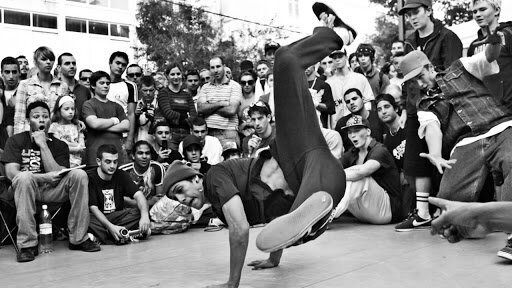
Street dance burst onto the scene in the 1970s as a vibrant form of cultural rebellion, born from the pulse of New York City's African American, Latino, and Caribbean communities. Fueled by the booming beats of hip-hop, funk, and electronic music, it wasn’t just a dance but a visual representation of the social, economic, and creative struggles faced by marginalized youth. At its heart was "breaking" (or breakdancing), where dancers transformed concrete sidewalks into dynamic stages, performing gravity-defying spins, freezes, and footwork. The battles weren’t just competitions—they were statements of identity, pride, and power. Over time, street dance expanded globally, inspiring new styles like popping, locking, and krumping. From underground street corners to global stages like "America's Best Dance Crew" and "World of Dance," street dance has become a universal language of self-expression, rebellion, and resilience.
1960s
The Birth of Funk Styles: In California, funk music begins to influence new styles of dance. Popping and locking emerge as distinct styles. Locking is popularized by Don Campbell ("Campbellocking") and the group The Lockers, while popping is associated with dancers like Boogaloo Sam and the Electric Boogaloos. These moves, originally performed in clubs, would later evolve into essential elements of street dance.
Early 1970s
Breaking (Breakdancing) Emerges in the Bronx: New York's South Bronx becomes the epicenter of breaking, also known as B-boying or B-girling. Influenced by DJ Kool Herc’s "breakbeat" style of music, dancers create a new art form centered around dynamic moves like toprock, downrock, freezes, and power moves (like spins and flips). Street dance becomes a symbol of cultural resistance for young people grappling with poverty and social marginalization. Hip-Hop Culture Is Born: DJ Kool Herc, Afrika Bambaataa, and Grandmaster Flash lay the foundations of hip-hop culture. The "Four Elements of Hip-Hop" are established: DJing, MCing (rapping), graffiti, and breaking. Breaking becomes a central feature of block parties and underground gatherings.
Mid to Late 1970s
Breaking Goes Mainstream: Breakdancing battles begin to be seen at local block parties, parks, and community centers. Crews like the Rock Steady Crew form, turning dance battles into high-energy performances. This is also when B-boys and B-girls develop their own "crew" culture, where groups of dancers represent their community or neighborhood in competitions.
1980s
Street Dance Enters Pop Culture: The media spotlight hits street dance. Movies like Flashdance (1983), Breakin’ (1984), and Beat Street (1984) expose breaking, popping, and locking to international audiences. The mainstream's exposure to street dance turns it into a global phenomenon, and B-boys like Crazy Legs and the Rock Steady Crew become household names. Breakdancing Moves to TV: Shows like Soul Train highlight funk styles like popping, locking, and roboting, influencing pop stars like Michael Jackson, who incorporates popping into his iconic "Moonwalk" in 1983. This period also marks the global spread of street dance, as American films, TV shows, and music videos inspire youth around the world.
1990s
New Styles Emerge: As street dance evolves, new styles are born. Krumping and clowning, rooted in Los Angeles, emerge as emotional and aggressive forms of street dance. Unlike breaking, which focuses on acrobatic moves, krumping emphasizes raw, expressive energy, rapid arm swings, and "hype" movement. Street Dance Becomes Part of Pop and R&B Music: Music videos from artists like Janet Jackson, Michael Jackson, and later, Usher and Missy Elliott, incorporate street dance into their choreography, making it a mainstream fixture. Commercialization leads to greater visibility but also criticism from the underground dance community, who see it as "watered down" for the mainstream.
2000s
Reality TV Dance Competitions: Shows like America’s Best Dance Crew (2008) and So You Think You Can Dance (2005) put street dance in the spotlight. Crews like Jabbawockeez and Quest Crew achieve international fame, and dance battles become highly produced, dramatic spectacles. This era sees the global explosion of street dance competitions, festivals, and workshops, allowing dancers from different countries to showcase their unique spin on classic street dance styles. New Styles Go Global: Turfing (from Oakland), Litefeet (from New York), and Jerkin' (from Los Angeles) develop as hyper-localized styles that later spread globally via YouTube and social media.
2010s
Street Dance Globalization: The internet becomes a major platform for the dissemination of street dance. YouTube and Instagram turn ordinary street performers into global dance stars, with viral choreography spreading trends worldwide. Global competitions like Red Bull BC One become prestigious events for breakdancers. Krumping, Flexing, and Voguing Resurgence: Street dance branches out, and marginalized communities continue to use it as a platform for self-expression. Krumping and voguing find new life in TV shows like Rupaul’s Drag Race and Legendary, where LGBTQ+ culture is celebrated.
2020s
Breakdancing Becomes an Olympic Sport: In 2020, the International Olympic Committee announces that breakdancing will debut as an official sport in the 2024 Paris Olympics. This marks a huge moment of recognition for street dance as a legitimate, competitive art form. TikTok Revolutionizes Dance: Short-form video platforms like TikTok push street dance into viral trends. Dancers choreograph short, repeatable moves that go viral within days, making street dance more accessible but also more commercialized. New Trends in "Hybrid" Street Dance: Street dance begins to blend with contemporary, ballet, and experimental movement styles. Online platforms allow for global collaboration between street dancers and contemporary choreographers, resulting in more hybridized and conceptualized performances.